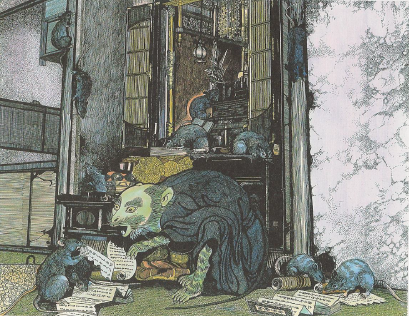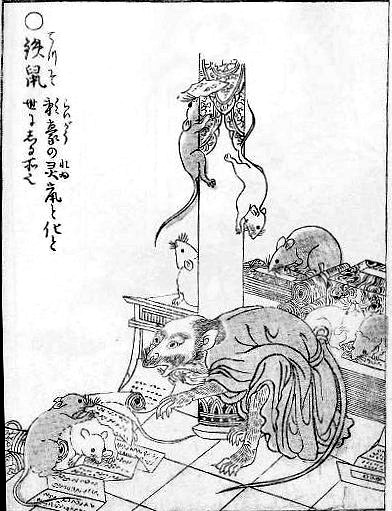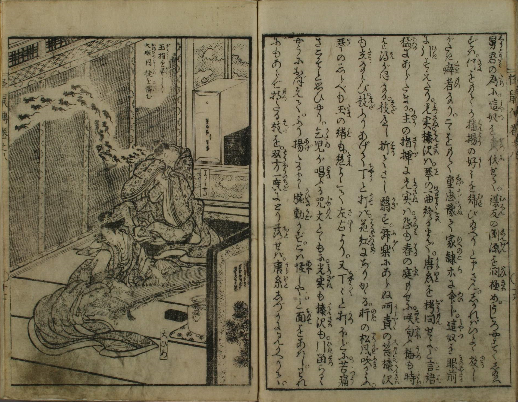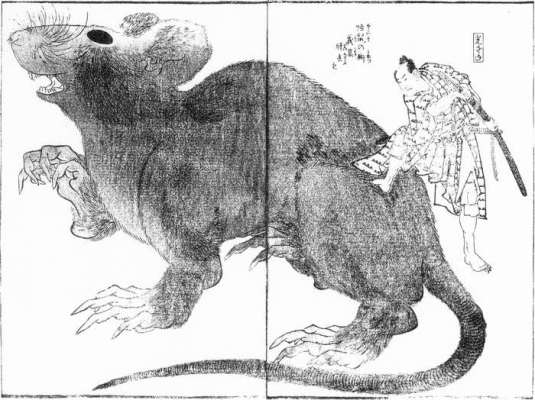Translated and Sourced from Mizuki Shigeru’s Mujyara, Kaii Yokai Densho Database, Japanese Wikipedia, and Other Sources
In Japanese folklore, if you make a promise you had better keep it—even if you are the Emperor of Japan. Otherwise, the person you betrayed might hold it against you and transform into a giant rat with iron claws and teeth and kill your first-born son. That is the story of the Emperor Shirakawa, his son Prince Taruhito, and the Abbot of Miidera temple Raigo—better known as Tesso, the Iron Rat; or more simply as Raigo the Rat.
What Does Tesso Mean?
The kanji for Tesso is about as straight-forward as you can get. 鉄 (te; iron) +鼠 (sso; rat). The name Tesso was given to this yokai by artist Toriyama Sekien in his yokai collection Gazu Hyakki Yako (画図百鬼夜行; The Illustrated Night Parade of a Hundred Demons,), although the character is much older.
Toriyama’s Text: The Abbot Raigo transformed into a monsterous rat.
Tesso is different from many yokai in that he is a singular character. There is only one Tesso. Until Toriyama came up with the much cooler name for his collection, Tesso was known as Raigo Nezumi (頼豪鼠), meaning Raigo the Rat.
The Story of Raigo the Rat
The tale begins with the Emperor Shirakawa, who was desperate for an heir to his throne. He enlisted the aid of the Abbot of Miidera temple, a powerful Buddhist monk named Raigo. Emperor Shirakawa promised Raigo vast rewards if he could use his spiritual powers to give the Emperor a son. Accepting the offer, Raigo threw himself into meditation and prayer and magic. Soon enough a son was born to Emperor Shirakawa, the Prince Taruhito.
Raigo went to the Emperor for his promised reward, and asked only for the funds to build an ordainment platform at his temple of Miidera. The Emperor was too happy to oblige, until temple politics interfered.
Miidera had a rival temple, the powerful Enraku-ji in Mt. Hiei in Kyoto. The monks of Enraku-ji were not normal, peaceful monks, but a terrible army of militant warriors feared across all Japan. It was said the Emperor could influence all on Earth except three things—the blowing of the wind, the rolling of dice in a cup, and the monks of Enraku-ji. Even though they were both of the Tendai sect of Buddhism, Miidera and Enraku-ji has split into different factions after the death of their founder. Enraku-ji was not about to allow new Tendai monks to be ordained at Miidera, a privilege they reserved for themselves.
The Emperor had no choice but to break his promise to Raigo. He asked if there was anything else he could give, but Raigo was adamant. So adamant, in fact, that he went on a hunger strike and died after 100 days, cursing the Emperor with his final breath. At the house of his death, a figure in white was said to have appeared beside the cradle of the 4-year old Prince Taruhito, who died soon afterward. What Raigo had given, Raigo had taken away.
What happened next was strange—up until now this is the usual ghost story with Raigo returning as a yurei. But the tale does not end there. Raigo used black magic to ensure he was reborn after death as a dread yokai. He twisted his body into the form of a giant rat as large as a man, with a body as strong as stone and with claws and teeth or iron.
The newly-named Raigo the Rat invaded Enraku-ji with an army of rats, devouring their rare and valuable Buddhist scriptures, and even eating statues of the of the Buddha himself. This reign of rat-terror when on until a shrine was built to appease Raigo, transforming him from a deadly emissary of vengeance into a protecting kami spirit. Because that’s how evil spirits roll in Heian-period Japanese folklore.
Raigo the Onryo
Old texts describe Raigo as an onryo, the name for the grudge-bearing spirit popular in Japanese horror films. Raigo wouldn’t be seen as an onryo nowadays—his transformation into a rat makes him more of a monster than a ghost. But in the Heian period the word onryo had a more specific meaning, being something with a grudge against the Emperor of member of the Imperial family. And that label suits Raigo just fine.
Raigo and the Heike Monogatari
The story of Raigo comes from the Heike Monogatari (平家物語; Tale of the Heike) an epic poem from the Heian period that tells of the Heike/Taira wars that split Japan as two factions struggled for the throne. The Heike Monogatari is often called Japan’s version of The Odyssey, freely mixing historical fact with the supernatural and mythological.
Because the Heike Monogatari comes from an oral storytelling tradition, there are multiple versions of it with variations of the story of Raigo the Rat. In one of the older versions—the Engyo Hon (延慶本; Book of the Engyo Period), the story ends with the death of Prince Taruhito. In later versions Raigo gets more and more monstrous. The 48-volume Genpei Seisuiki version has Raigo attacking Enraku-ji with his army of rats, and in the 14th century historical epic Taiheiki (太平記; Record of the Great Peace) Raigo is described as having a body of stone and claws and teeth of iron. This Raigo ate not only the sacred texts of Enrakuji, but also their statue of Buddha.
Other Tales of Raigo
Raigo the Rat was a popular enough character that other writers continued the story after the Heike Monogatari. For example, a collection of Tanka poems from Otsu city, Shiga prefecture called Kyoka Hyakumonogatari (狂歌百物語; A Hundred Stories of Satirical Poems) featured the poem Raigo of Miidera and retold the story from the Heike Monogatari.
During the Edo period, author Gyokutei Bakin wrote the story Raigo Ajari Kaisoden (寺門伝記補録; The Tale of the Abbot Raigo who Transformed into a Monsterous Rat), illustrated by famous ukiyo-e artist Katsushika Hokusai.
Gyokutei puts Raigo into a different historical narrative, telling the story of Shimizu Yoshitaka (also known as Minamoto no Yoshitaka), the orphaned son of Minamoto no Yoshihara. Yoshitaka was on a pilgrimage of holy sites when he had a vision of the Raigo, who told Yoshitaka he would teach him the secrets of black magic and help him amass an army to take vengeance against his father’s killers. All Yoshitaka has to do is write an official request for help, and place it before Raigo’s shrine along with a donation.
Yoshitaka does as requested (of course), and soon finds himself in possession of Raigo’s shape-changing ability and mastery over rats. As an additional twist, Yoshitaka is hunted by Nekoma Mitsuzane (who’s name ironically begins with the kanji for “cat” in a traditional cat-and-mouse game). In one scene, Nekoma finds Yoshitaka and is about to kill him when a massive rat leaps to Yoshitaka’s defense. In another scene, Nekoma is torturing Yoshitaka’s mother-in-law and Yoshitaka leads and army of rats to her defense, saving the day.
Hundreds of years later, Raigo still has a hold on the popular imagination. Modern author Kyogoku Natsuhiko used the story of Raigo as the basis for his mystery novel “Tesso no Ori” (鉄鼠の檻; The Cage of the Tesso).
The Historical Raigo
Although the tale of Raigo the Rat is fictional, most of the key players are historically verified. Shrine records show Raigo was the Abbot of Miidera, and at one time petitioned Emperor Shirakawa for funds to build an ordination platform—a petition that was denied. There is little doubt that rival temple Enraku-ji played some hand in the denial. At the time, Enraku-ji’s power was absolute.
The only person not involved in the affair was Prince Taruhito. Records put the young Prince’s death in 1077, while Raigo himself died in 1084. This contradicts the facts of the legend.
Rats, of course, were an actual source of fear to the fragile book collections of temples across all of Japan. So it is no wonder that a double-punch of an angry spirit and a scroll-eating rat was a natural mixture for Kaidan.
Tesso Shrines
There are a couple of supposed shrines to Raigo, each claiming to be THE shrine that ended Raigo’s scroll-devouring revenge.
In Hyoshi Taisha, in the Sakamoto district of Otsu city, Shiga prefecture, there is a shrine called the Shrine of the Rat that some connect to Raigo. Shrine records, however, say that the shrine is dedicated to the Rat God of the Chinese Zodiac and not to Raigo.
Miidera shrine has the most obvious connection, and has a small monument and shrine dedicated to Raigo also called the Shrine of the Rat. This shrine faces directly at Mt. Hiei in Kyoto and is said to be placed in defiance of Enraku-ji’s role in Raigo’s curse.
However, Mt. Hiei has their own shrine—the Shrine of the Cat—that looks directly at Miidera. Some suspect the two shrines are connected by an older legend of a monk who summoned a giant cat to destroy a giant rat that was menacing the area.
In truth, probably both of these Shrines of the Rat were re-dedicated to suit interests in the story. Like Relics in Catholic churches, a shrine or artifact connected to a popular legend can mean tasty tourist dollars and neither Buddhist temples nor Shinto shrines never let the facts get in the way of a good story. Especially one that attracted tourists.
Translator’s Note:
This was translated for Mike Mignola, who picked out Tesso from a copy of Mizuki Shigeru’s Mujyara that I showed him at Emerald City Comic Con. Mignola liked the illustration of Tesso, and I am only too happy to give him the story behind the image.
Plus, I did a lot of cats last year. It is only fair that at least one rat gets to appear as well.








Apr 08, 2013 @ 21:05:48
Very cool- thanks for sharing. This is yet another myth I’ve not seen before you bringing it to my attention.
Apr 08, 2013 @ 21:08:23
nicely done…………..an informative, educational and fun read. excellent selection of illustrations as well. rock on, mark in kamakura
Apr 08, 2013 @ 21:35:52
Brilliant story– thanks for posting it!
I’m curious: to what extent were stories of Raigo believed by their audiences? I know that yokai legends (as with most legend collections) often mix pure fiction with actual belief, and that things become very complex over time. I know a person, for instance, whose mother swears she saw Kuchisake-onna.
Also, do you mean THE Mike Mignola?
Apr 08, 2013 @ 21:52:28
The modern urban legends of Kuchisake-onna scared the wits out of many young kids a few decades back. When I brought up the topic with my 49-year-old wife, she abruptly said “Stop it. I don’t wanna talk about her. She scared the hell out of me and my classmates. I’d rather just forget it.” As to older legends from the Edo period, one can only speculate. Have you never played the Ouija board game? That even scared the hell out of me in my youth…………The Japanese had a somewhat similar game called Kokkuri 狐犬狸 「こっくり」. Literally “Fox, Dog, and Tanuki.” Kokkuri was an extremely popular mass-culture divination game in the 1880s. See http://www.onmarkproductions.com/html/tanuki.shtml#misc and then scroll down for details.
bye now, mark
Apr 08, 2013 @ 22:49:12
Is there any other Mike Mignola? Yes, he of Hellboy fame. He’s as much a master of folklore as MIzuki Shigeru, and I always love talking with him when I get the chance.
As to what extent they were believed … I would say during the Edo period and before the belief was absolute. In modern times … well … the monks at the Temples act like the story is 100% real. Take that for what you will.
As Mark said, the kuchisake-onna is a whole different story. She is modern, an urban legend and you will find people that absolutely swear they have seen her. But then again, I’ve seen the Loch Ness Monster, so what do I know?
Apr 09, 2013 @ 13:20:04
I already knew Tesso from the awesome book “Yokai Attack!´´, but this post is very complete and provides more info, I have learnt a lot *-*
Btw, there are some Yokai that are very obscure and I would love learning about them, like the Honekarakasa, Kurayaro, Eritategoromo and Hahakigami, it would be great if you could fin info about them, translate it and post it here.
Apr 09, 2013 @ 13:24:41
Thanks Blue Satan. I probably won’t be doing obscure yokai anytime soon — I usually have a sort of vague plan of what I will do next that I stick too, unless something crops up like this one for Mike Mignola. I still plan to do Hashihime, and then I will be doing a series of yokai that appear in my translation of Mizuki Shigeru’s “Showa: A History of Japan.” Most of those are pretty familiar, but I find that there is always more to be discovered about them.
That’s my plan for now, at any rate! Things can always change!
Apr 09, 2013 @ 13:46:52
Wow, thanks for the quick reply! Well, I will wait till someone post that obscure yokai, or just learning japanese will do XD But there are a lot of other yokai that are very interesting and I want to know more about them, so be prepared!
That Yokai of “Showa: A history of Japan ´´could be very interesting. I´ll be waiting for them! And I completely agree with you: there is always more to be discovered about all the yokai, so keep up the good work!
Btw, I´m planning on getting the book “The great Yokai enciclopaedia´´ cause I need more info about some yokai for my blog, and I was thinking if you could give me your opinion about this book; if it´s worth it or not and your personal opinion. Thanks!
Apr 09, 2013 @ 13:50:21
I’d like to do some more obscure ones some day as well. Just a matter of time.
If you are looking for a yokai book, I recommend “The Night Parade of a Hundred Demons.” It’s my favorite English-language book.
Apr 09, 2013 @ 22:39:26
I already have that book; is very useful and complete and I follow the blog of his author, Matt Meyer.
I’m looking for info about the widest variety of yokai as I can, that´s because I wanted to get “The great Yokai enciclopaedia´´. I thought that in this book I could find something about any unknown yokai or about any obscure yokai from the collection of Toriyama Sekien…
Apr 10, 2013 @ 09:50:19
I’ve never read “The Great Yokai Encyclopaedia,” so I can’t really comment on it. The author, Richard Freeman, comments on here from time to time. I’m sure it’s a great book and I would love to read it sometime. If you get a copy, report back and tell us all about it!
Apr 10, 2013 @ 10:00:59
If I happen to see him around here, I’ll ask him what type of yokai can I find in his book. I’ll buy that book soon or later, and I’ll post my impressions here for sure when that occurs!
Apr 10, 2013 @ 10:08:42
Btw, I recently have read the book “The legends of Tono´´. It´s an awesome book and a masterpiece of japanese literature. It has become one of my favourite books and is a treasure for me, and I have posted my impressions and the review on my blog!
Apr 10, 2013 @ 10:24:31
“Legends of Tono” is a great book. Mizuki Shigeru did a comic version of it as well, that I hope gets an English translation some day. I have translated about 1/3 of his comic on my own just for fun.
Apr 10, 2013 @ 10:47:13
I’m looking forward to read the manga version of Tono, because it´s amazing. Hope we can read the translation someday, and better if you translate it!
Apr 10, 2013 @ 11:57:25
That’s all up to Drawn & Quarterly, and how many people support the current Mizuki Shigeru releases. If you want to see more, be sure to pre-order “Showa: A History of Japan.” Pre-orders go a long way to determining if more Mizuki books get on the schedule!
Apr 10, 2013 @ 23:25:50
As a Paranormal Researcher and Occultist I believe the legends are one and the same. That being said, a lot of East Orient countries have seem to pass on knowledge Esoterically (un- written, focusing on Oral traditions) so maybe Raigo’s ghost killed the Emperor’s heir later on.
On another note Japan has some crazy Ass legends. One province claims Jesus didn’t die on the Cross, he died in Japan after marrying a Japanese woman and baring children. Check it out :
http://www.smithsonianmag.com/history-archaeology/The-Little-Known-Legend-of-Jesus-in-Japan-183833821.html?device=android
Apr 10, 2013 @ 23:28:26
I mean the legends AND history are one and the same.
Apr 16, 2013 @ 21:36:05
Never liked rats. :S
This is one I’ve not heard of before!
I like the idea of there being a Japanese-styled ‘Odyssey.’ That’s kinda fun~
By the way – I just thought I’d mention that I’m starting up a Japanese-English translation business. I know you do a lot of translation work here yourself, but if you or someone you know needs some extra help, let me know! > >
http://angrygaijin.wordpress.com/japanese-english-translator-for-hire/
Aug 24, 2017 @ 08:49:51
Reblogged this on Rattiesforeverworldpresscom.
Jul 02, 2019 @ 13:30:23
HELLO, I LOVED YOUR INFO ON RAIGO/TESSO HE’S ONE OF (IF NOT MY BIGGEST) FAVORITE YOKAI! ^_^
I KNOW THIS MAY BE SOMEWHAT LATE SO PLEASE FORGIVE ME EVERYONE BUT…I HAVE A QUESTION…AND SINCE THIS IS A SITE ABOUT YOKAI I THOUGHT I’D ASK FOR HELP HERE.
BUT FIRST…FOR THOSE WHO DO NOT KNOW, I AM NOT TYPING LIKE THIS TO YELL, I HAVE EYE ISSUES SO I TYPE LIKE THIS TO SEE BETTER, THANK YOU. ^_^
HAS ANYONE EVER READ A JAPANESE STORY CALLED “RAIGO AJARI KAISODEN”?
I KNOW IT’S AN OLDER STORY BUT PLEASE BARE WITH ME,
I’M TRYING TO FIND OUT HOW IT GOES (SINCE I CANNOT SPEAK/TRANSLATE JAPANESE) I WOULD LOVE TO KNOW HOW THE STORY GOES (FROM MORE THEN JUST A FEW SENTENCES IF POSSIBLE, BECAUSE THERE’S NOT MUCH INFO ON IT. I WISH I COULD READ IT, IT SOUNDS LIKE A GREAT SORY).
PLUS, ON A MORE PERSONAL AND MORE IMPORTANT NOTE, I’M WRITING MY OWN STORY ABOUT THE “CHARACTER” NAMED “RAIGO” AND I’M TRYING TO GRASP HIS PERSONALITY FROM OTHER STORYTELLERS, AND SO FAR, IT’S NOT BEEN SO GOOD, (ONE BIG THING I WANT IS IF ANY ARE PRESENT, I WANT MORE QUOTES FROM HIM, I’VE ONLY SEEN TWO OR THREE IN OTHER STORIES THAT WERE TRANSLATED, AND IT WASN’T MUCH HELP ON TERMS OF GETTING HIS PERSONALITY TRAITS DOWN, (OR AT LEAST HOW PEOPLE THINK HE ACTED BACK THEN).
SO IF SOMEONE COULD HELP ME OUT BY TELLING ME HOW HE ACTED/SPOKE IN THE STORY IN QUESTION I WOULD BE TRULY GRATEFUL (I KNOW IT’S NOT ACCURATE IN TERMS OF HISTORY AND I KNOW NO ONE CAN BE THAT CLOSE, BUT I FELL I WANNA AT LEAST LOOK AT SOMEONE ELSE’S PERSPECTIVE OF HIM WHO MAY BE CLOSER TO THE LEGEND SO TO SAY IF THAT MAKES SENSE).
THANK YOU FOR READING AND HAVE A GREAT DAY/NIGHT AND PLEASE FORGIVE ANY GRAMMAR/SPELLING ERRORS IF THERE ARE ANY.
Jul 02, 2019 @ 14:51:06
I AM NOT TYPING LIKE THIS TO YELL, I HAVE EYE ISSUES AND NEED TO TYPE IN CAPS TO SEE THE LETTERS BETTER, PLEASE DO NOT BE OFFENDED OR MISTAKE THIS AS YELLING, SO PLEASE I BEG OF YOU, DO NOT DELETE THIS COMMENT, I DO NOT WISH TO BOTH/TROLL OTHERS, I REALLY, REALLY NEED HELP WITH SOMETHING!
THANK YOU. 🙂
HELLO…I AM WRITING MY OWN STORY ABOUT RAIGO/TESSO AND ALTHOUGH I AM FULLY AWARE OF THE LEGEND, AND HAVE READ SOME TRANSLATED THINGS THAT GIVE A (VERY SMALL) BIT OF MORE INFO ON HIS PERSONALITY, I AM LOOKING FOR A MORE DETAILED STORY, (AND HONESTLY AS I KIND OF MENTIONED BEFORE, I NEED SOMETHING THAT ISN’T JUST A FEW SUPPOSED “QUOTES” FROM HIM AND/OR ONE PAGE DESCRIBING HIS LEGEND). NOT THAT THOSE ARREN’T ANY GOOD/HELPFUL OF CORSE
BUT I NEED MORE DETAIL, THE REASON BEING FOR “RESEARCH” SO I KNOW WHETHER I AM “DOING HIM JUSTICE” SO TO SAY AND NOT MAKING A SOMEWHAT “OUT OF CHARACTER” VERSION OF HIM.
THE BOTTOM LINE IS THAT I FIGURED “RAIGO AJARI KAISODEN” WAS THE WAY TO GO, BUT I CANNOT TRANSLATE IT, NOR CAN I READ JAPANESE, PLUS, (POSSIBLY THE HARDIEST REASON BEING) THAT FINDING THE STORY IS HARD (FOR OBVIOUS REASONS, SINCE IT’S AN OLDER TALE).
SO IF SOMEONE COULD MAYBE GIVE ME SOME QUOTES/ACTIONS HE DID, IN A BIT MORE DETAIL YOU DON’T HAVE TO TELL ME THE HOEL STORY (UNLESS YOU WANT) BUT I NEED AS MUCH AS YOU CAN GIVE…IF IT WERE ENGLISH AND IF I COULD FIND IT, I’D READ IT MYSELF, NOT JUST FOR RESEARCH/INFORMATION GATHERING BUT BECAUSE I THINK IT SOUNDS LIKE A GOOD STORY.
HOWEVER, IF IT ISN’T THE STORY THAT I’M LOOKING FOR, AND THERE’S ANOTHER ONE THAT COULD HELP ME, THEN PLEASE, FEEL FREE TO TELL ME ABOUT IT.
THANK YOU ALL, AND HAVE A WONDERFUL DAY/NIGHT. 🙂
Jul 02, 2019 @ 21:47:25
LOVE YOUR YOKAI REVIEWS! GREAT WORK, I KNOW IT’S LATE (AND SORRY IF I SEEM TO POST TOO MUCH, ID MEAN TO THE COMMENT SYSTEM WAS WEIRD EARLIER TODAY).
Jul 02, 2019 @ 21:49:00
HELLO, I HAVE A QUESTION…
BUT FIRST…FOR THOSE WHO DO NOT KNOW, I AM NOT TYPING LIKE THIS TO YELL, I HAVE EYE ISSUES SO I TYPE LIKE THIS TO SEE BETTER, THANK YOU. ^_^
HAS ANYONE EVER READ A JAPANESE STORY CALLED “RAIGO AJARI KAISODEN”?
I KNOW IT’S AN OLDER STORY BUT PLEASE BARE WITH ME,
I’M TRYING TO FIND OUT HOW IT GOES (SINCE I CANNOT SPEAK/TRANSLATE JAPANESE) I WOULD LOVE TO KNOW HOW THE STORY GOES (FROM MORE THEN JUST A FEW SENTENCES IF POSSIBLE, BECAUSE THERE’S NOT MUCH INFO ON IT. I WISH I COULD READ IT, IT SOUNDS LIKE A GREAT SORY).
PLUS, ON A MORE PERSONAL AND MORE IMPORTANT NOTE, I’M WRITING MY OWN STORY ABOUT THE “CHARACTER” NAMED “RAIGO” AND I’M TRYING TO GRASP HIS PERSONALITY FROM OTHER STORYTELLERS, AND SO FAR, IT’S NOT BEEN SO GOOD, (ONE BIG THING I WANT IS IF ANY ARE PRESENT, I WANT MORE QUOTES FROM HIM, I’VE ONLY SEEN TWO OR THREE IN OTHER STORIES THAT WERE TRANSLATED, AND IT WASN’T MUCH HELP ON TERMS OF GETTING HIS PERSONALITY TRAITS DOWN, (OR AT LEAST HOW PEOPLE THINK HE ACTED BACK THEN).
SO IF SOMEONE COULD HELP ME OUT BY TELLING ME HOW HE ACTED/SPOKE IN THE STORY IN QUESTION I WOULD BE TRULY GRATEFUL (I KNOW IT’S NOT ACCURATE IN TERMS OF HISTORY AND I KNOW NO ONE CAN BE THAT CLOSE, BUT I FELL I WANNA AT LEAST LOOK AT SOMEONE ELSE’S PERSPECTIVE OF HIM WHO MAY BE CLOSER TO THE LEGEND SO TO SAY IF THAT MAKES SENSE).
THANK YOU FOR READING AND HAVE A GREAT DAY/NIGHT AND PLEASE FORGIVE ANY GRAMMAR/SPELLING ERRORS IF THERE ARE ANY.